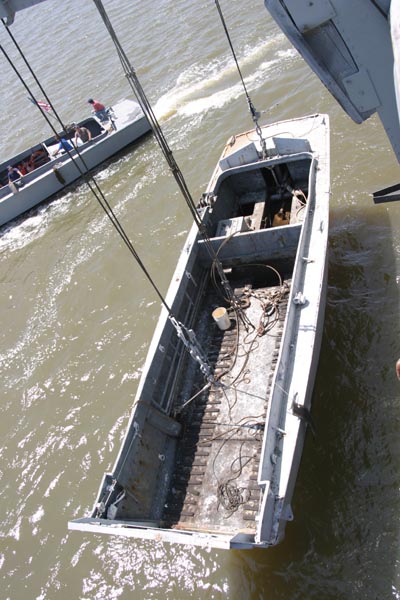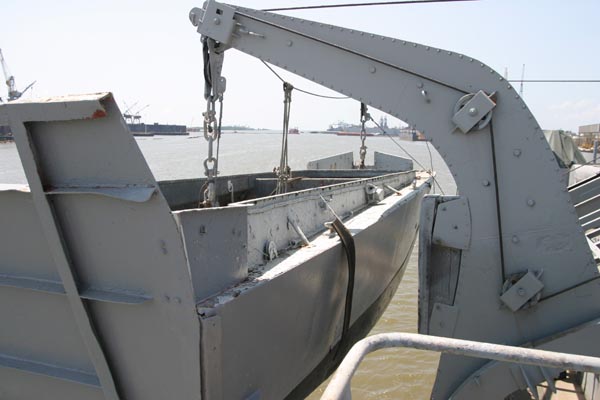More Haskell-class APA minutia - how are the outboard LCVPs hung from the four strongbacks (2 each port and starboard)? I’ve found photos showing Haskell LCMs being hoisted out with a 4-point sling from the aft cargo boom, but nothing specific for the LCVPs being lowered from the strongbacks. I’m assuming a 2-point attachment, like a lifeboat, based on fuzzy photos taken from too far away. But somehow that just seems intuitively too … flimsy?
That’s a great picture of the boat falls connecting into the LCVP, but it is a different kind of davit from the triple Welin davit on the APA that supports three LCVPs. Note that two boat falls support the weight of the boat and I believe the center group of lines are just dangling there.
These pictures are on an LST, where there is only one LCVP per davit, and it sits on the cradle formed by the end pieces, as you can see by the last picture at the site that you linked to.
On the APA, there are two LCVPs sitting inside the end pieces, so they are farther apart, and the third boat is suspended outboard by the strongback, with no cradle at all.
Cool pictures, and now I’m looking forward to modeling an early LST.
Thanks,
Rick
The picture shows where the boat falls are attached to the LCVP, it doesn’t rally matter which type of davit the upper end of the falls are attached to. The hoisting points in the LCVP was standard throughout the fleet. The strongback would have at least 4 blocks on it; one block over each of the LCVP hoist points; and one block near the davit arm. The block near the davit arm would lead the fall to the boat hoist, possibly through some more blocks.
Now that you mention it, that’s right. The question I was thinking about was “How was the boat suspended off the framelike Welin triple davit”. I was thinking about the top and your photos show the bottom of the boat falls just perfectly.
There are a few distant, but still pretty good pictures available of other APAs. One of Bexar http://www.ussbexar-apa237.org/albums/album_image/935341/298220.htm and one on Navsource on the page for Amphibious=> APA/LPA => APA-227 Renville, atthe bottom of the page. They show the way the boat falls come off the strongback.
Thanks for those pics, CG Bob, that’s exactly what I was looking for! The instructions for the kit said to make a kind of sling at each end of the LCVPs with leftover PE block and tackle and wrap it around the boats, but that just looked “wrong” to me. This makes a lot more sense, plus it’ll be easier to model.
You know, this subject was just what I needed to address on my Montrose kit (Navarro, actually) that I am finally getting wrapped up. For that third boat that is on the triple Welin davit, I knew it couldn’t be glued to the side of the inboard boat, the way Revell built them to be, and your snippet from Loose Cannon’s instructions brings it together, in combination with the boat falls that CG Bob shows us.
There are good photos in Friedman’s “US Amphiobious Ships and Craft - an illustrated design history”, but they are really just similar to photos on navsource. And they indeed show that the boats were hanging with the falls attached inside, but outside, there was lashing wrapped around the boat holding it fast to the inboard boat, as your instructions say.
The system of simply damgling them from the boat falls (like a lifeboat) would only be used during raising or lowering operations, just as in the photo series that CG Bob shows us on the LST site.
So now I know how to mount the boats on the Montrose kit. Thanks!
Rick
And now that I am(almost) to that stage of attaching those LCVPs, two questions:
- How many were in the crew? My research indicates 3. I’m going to have a few of these in motion.
- I’m guessing that the heavy, wide rope debarkation ladders were stowed along the inside edge of the bulwark at deck level at each debarkation station, then just heaved up and over the bulwark to dangle along the side of the hull, so I plan to bend mine so they kind of “hook” over the bulwark. Should pass muster in 1/700, unless I have the stowage method wrong.
-
Three, perhaps four with the officer in charge of the attack wave. Coxwain, & two gunners. One’s duty was to be bow man to see to the lowering & raising of the ramp. On logistics runs without the need for guns the manning would be 2 (coxwain & bowman).
-
It depends. Check your references. Many APA/AKA photos do not show nets deployed, but there again there is the exception which disproved the rule – USS Oberon, my father’s ship – with nets stowed outboard of the bulkhead

Regardless, be sure you include the spreaders on the nets which are deployed.

Ed to the rescue again … many thanks!
One last one for either Ed or Dr. Tilley - on *Haskell-*class AKAs, the LCVPs stowed over the holds were kept on large racks. Did the racks come apart if the holds had to be opened? I’m thinking specifically of the No. 4 hold, furthest aft, the top of which my research indicated held a pair of LCMs with LVCPs nested on top … I have opened up that hold to show some LVTs being hoisted aboard, but haven’t found any good pics of how the LCMs/LCVPs were stowed once the hold was closed and battened down. There had to be some kind of framework to keep those big clunky LCMs from sliding all over the place, didn’t there?
I don’t have a good source regarding the framework for stowing boats on the hatch covers, but mfsob must be right: it had to be there, and it had to come apart in a hurry.
Some years ago, when I was working on drawing project for the Coast Guard Historian’s Office, I had to work up a drawing of the APA Joseph P. Dickman, one of the early attack transports that were converted from liners (and manned by Coast Guard crews). I had to work mainly from photos, some of which showed a rather elaborate framework on which four LCVPs were stowed about eight feet above the after well deck. None of the photos was clear enough to show just how this mechanism worked; it apparently was set up so the crew could work on the deck with the landing craft over their heads. And two LCMs were stowed on the forward well deck - presumably on top of the forward hatch covers.
I do remember my father telling me about one exasperating feature of those davits. (I think I may have told this anecdote before; if so, stop reading here.) Part of the gear consisted of a heavy steel cable that ran from a block near the edge of the deck to a winch next to the superstructure. Said cable ran about eight or ten inches above the deck - just the right height (especially at night, in a blacked-out ship) to catch an unwary person in the shin and bring him crashing to the deck, frequently with a black eye and/or a broken nose. The cables were generally covered with grease, and paid no regard to rank. The unofficial insignia of the U.S. Amphibious Forces was a dark stained line across the trouser legs.
Guys
I’m new to this forum so what I have to say may be old news. First I was an officer on a Haskell class APA in the 1960s. We had 24 boats on board. Most were LCVPs although we had 3 LCPLs and 2 LCMs. 12 of the LCVPs were stowed on triple bank Welin Davits, the remainder were stowed using swinging cargo booms. We no longer carried LCVPs stowed in the LCMs although the portable cradles to do it were on board. With regard to the Welin davit there was a beam between the two davit arms that carried the tackle for raising and lowering the boats. The boats were stowed in cradles between the arms except for the third boat that was hung from the beam between the arms. The cradles for the upper inboard boat swung out of the way so you could reach the third boat, stowed on deck. Yes the cable to the davit winch ran across the deck at the right height to catch your ankle and you quickly got grease marks across your pants. They were called “gator hash marks”. The LCVPs no longer carried machine guns. The crew consisted of a coxswain, a bow hook, and an engineer. A wave of boats would have an officer in charge in one of the boats, known as “the wave guide commander”. The cradles for all boats stowed on deck were permanent and would be outboard of a hatch although the boat would cover the hatch making it impossible to open it with the boat on board. All embarkation stations had embarkation nets. When not in use these rolled up and were stowed in board of the rail at the embarkation station.
Anyway, if anyone has question regarding the landing craft carried by an APA, The color scheme used in the 1960s, the method of launching them, or the embarkation and loading procedures fire away.

